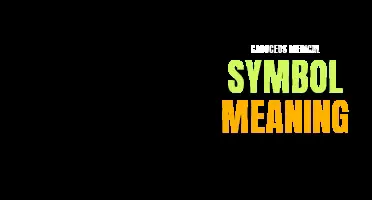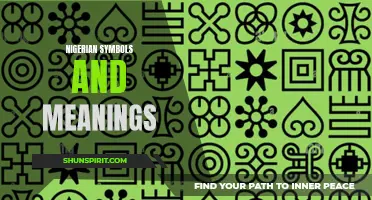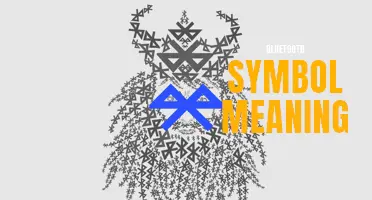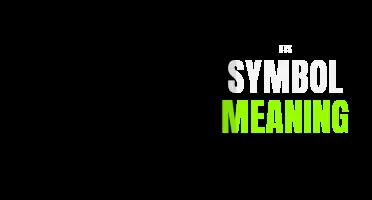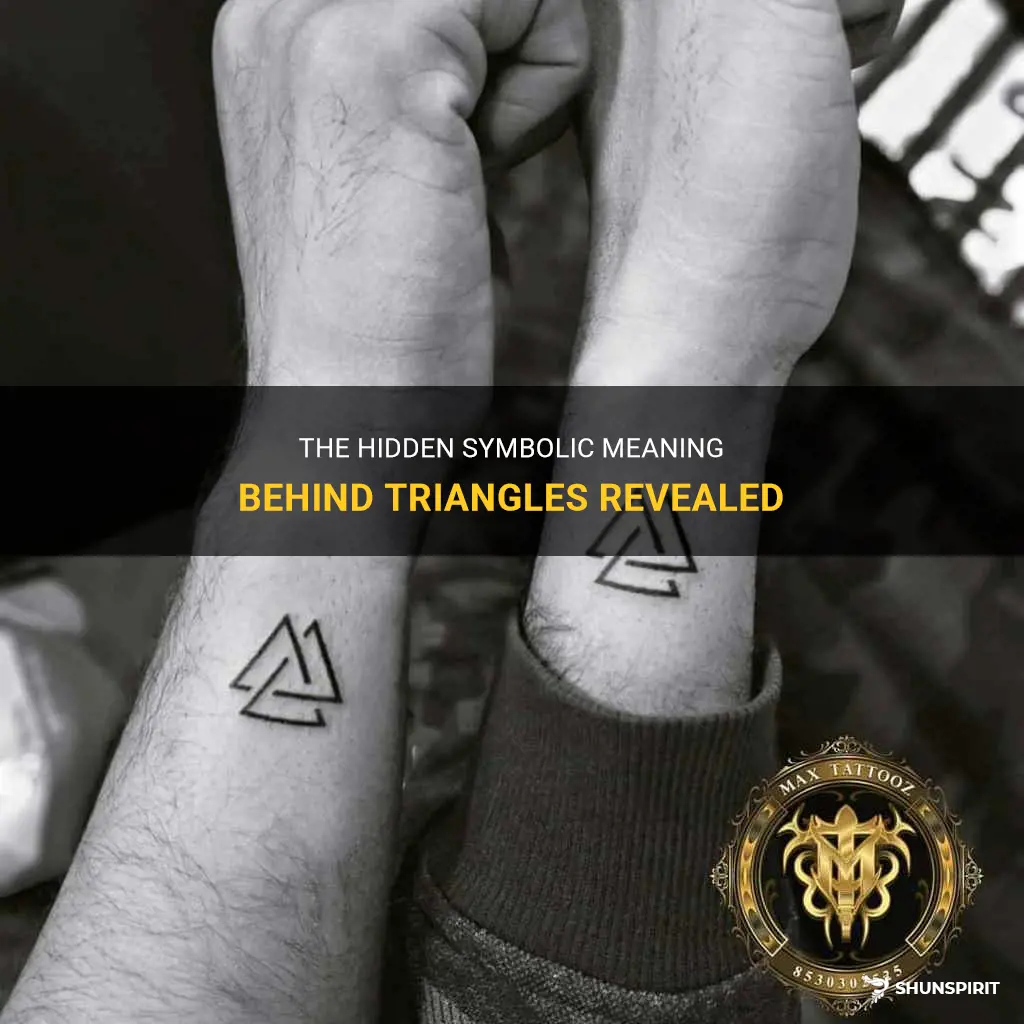
The triangle, with its simple yet powerful shape, has been used as a symbol across cultures and disciplines for centuries. From ancient civilizations to modern spiritual practices, the triangle holds a deep and diverse meaning that resonates with humanity's quest for understanding and connection. Whether it represents the three aspects of life, the trinity of divine forces, or the harmony of mind, body, and spirit, the triangle's symbolic significance is as captivating as it is inspiring. Join us on a journey through the rich tapestry of triangle symbolism, where we explore its various interpretations and delve into the profound truths it unveils about our existence.
What You'll Learn
- What is the symbolic meaning of a triangle?
- How has the triangle been used as a symbol throughout history?
- Are there different interpretations of the triangle's symbolic meaning in different cultures?
- What are some common associations or themes associated with the triangle symbol?
- Can you provide examples of artworks or literature where the triangle symbol is used and what it represents in those contexts?

What is the symbolic meaning of a triangle?
The triangle is a geometric shape that has been used as a symbol in various cultures and contexts throughout history. Its three sides and three angles give it a sense of stability and strength, and this symbolism is often reflected in its symbolic meanings.
In many spiritual and mystical traditions, the triangle represents the union of mind, body, and spirit. It is said to symbolize the balance and harmony between these three aspects of the self. This interpretation can be found in ancient spiritual practices such as yoga and meditation, where the triangle is often used as a visual focal point for achieving inner equilibrium.
The triangle also carries symbolic meanings in the realm of spirituality and mysticism. The upward-pointing triangle is commonly associated with the element of fire and represents aspiration, inspiration, and the divine masculine. Conversely, the downward-pointing triangle is associated with the element of water and is said to symbolize intuition, receptivity, and the divine feminine. When combined, these two triangles create the symbol of the Star of David, which is one of the most ancient and widely recognized symbols in Jewish culture.
In addition to its spiritual connotations, the triangle also carries symbolic meanings in other cultural and societal contexts. For example, in mathematics and science, the triangle is often used to represent the relationship between three variables or concepts. It is also a fundamental shape in architecture and design, as it can be used to create stability and balance in structures.
Furthermore, the triangle has been used as a symbol in various organizations and societies. In Freemasonry, for instance, the triangle, or the "Delta," is used to represent the principle of deity and the three essential elements of matter: solid, liquid, and gas. It is also used as a symbol of the Holy Trinity in Christian iconography.
Overall, the symbolic meaning of the triangle is multifaceted and can vary depending on the cultural, spiritual, and societal context in which it is used. Its inherent stability and balance make it a powerful symbol that represents unity, harmony, and the interconnectedness of various aspects of life. Whether used in spiritual practices, mathematical equations, or organizational emblems, the triangle carries a depth of meaning that has resonated with humanity for centuries.
Understanding the Symbol Ca2+ in Chemical Notation
You may want to see also

How has the triangle been used as a symbol throughout history?
The triangle is a geometric figure with three sides and three angles. Throughout history, the triangle has been used as a symbol in various ways, representing different concepts and meanings.
In ancient civilizations, the triangle was often associated with the divine and spiritual realms. The pyramids of Egypt, for example, were constructed in the shape of triangles, representing the connection between the earthly and heavenly realms. Triangular shaped tombs were also common in many ancient cultures, symbolizing the transition from life to death and the afterlife.
In religious symbolism, the triangle has been associated with the Holy Trinity in Christianity. The triangle is often used to represent the Father, Son, and Holy Spirit, or God's threefold nature. This symbol can be seen in religious art, stained glass windows, and on religious icons.
In alchemy, the triangle symbolizes the three elements of life - spirit, mind, and body. The upward-facing triangle represents the spiritual aspect, while the downward-facing triangle represents the material or earthly aspect. The union of these two triangles creates the symbol of the star, representing the perfect balance between the spiritual and material worlds.
The triangle has also been used as a symbol of strength, stability, and harmony. In architecture, triangular shapes are often used to provide structural support and balance. The use of triangles in bridges, buildings, and other structures helps distribute weight evenly and create stability.
In modern times, the triangle has been adopted as a symbol for various movements and organizations. The pink triangle, for example, was used by the LGBTQ+ community as a symbol of pride and identity. Originally used by the Nazis to identify and persecute homosexuals in concentration camps, the pink triangle was reclaimed by the LGBTQ+ rights movement as a symbol of resilience and liberation.
Similarly, the black triangle has been used as a symbol for various feminist movements. Originally used by the Nazis to identify individuals deemed "antisocial," the black triangle has been repurposed by feminists to represent strength, solidarity, and resistance against oppression.
In mathematics, the triangle is a fundamental shape used to study geometry and trigonometry. The Pythagorean Theorem, one of the most famous theorems in mathematics, is based on the relationships between the sides of a right-angled triangle. Triangles are also used to study angles, areas, and other geometric properties.
In conclusion, the triangle has been used as a symbol throughout history to represent various concepts such as divinity, balance, strength, and identity. From ancient civilizations to modern movements, the triangle continues to play a significant role in human culture and symbolism.
The Meaning Behind Disability Symbols: Promoting Inclusion and Accessibility
You may want to see also

Are there different interpretations of the triangle's symbolic meaning in different cultures?
The triangle is one of the most basic and fundamental shapes in geometry, and it has been used as a symbol in various cultures throughout history. The symbolic meaning of triangles can vary depending on the culture and the context in which they are used.
One interpretation of the triangle is that it represents the threefold nature of existence. In many ancient cultures, such as the Egyptian, the triangle was associated with the concept of the trinity – the idea that everything in the world is made up of three elements. For example, in Egyptian mythology, the triangle represented the three gods Osiris, Isis, and Horus, who were considered to be the divine family responsible for the creation and continuation of life.
In other cultures, the triangle has been associated with the elements. In alchemy, for instance, the triangle represents the three basic elements of earth, air, and water. The upward-pointing triangle is often associated with fire, while the downward-pointing triangle is associated with water or earth. The combination of these two triangles, the upward and downward triangles, can be seen as representing the balance and harmony of the elements.
In some spiritual traditions, the triangle is symbolically linked to the concept of the divine feminine. The upward-pointing triangle is associated with the goddess, the divine mother, or the feminine principle, while the downward-pointing triangle represents the god, the divine father, or the masculine principle. These two triangles together form the symbol of the Star of David, which is often associated with the union of opposites and the integration of male and female energies.
It is also worth noting that the orientation of the triangle can change its meaning. For example, an upright triangle is often seen as a symbol of stability and strength, while an inverted triangle can be seen as a symbol of vulnerability or receptivity.
Overall, the symbolic meaning of triangles can vary greatly across different cultures. While there are common threads and universal interpretations, such as the representation of the trinity or the elements, the specific associations and meanings can vary widely. It is important to take into account the cultural and historical context when interpreting the symbolic meaning of the triangle in any given culture.
Exploring the Beautiful and Timeless Symbols That Represent Eternity
You may want to see also

What are some common associations or themes associated with the triangle symbol?
When it comes to symbolism, the triangle is a shape that often carries multiple associations and themes across different cultures and contexts. Whether it's in religion, mathematics, or even mysticism, the triangle has appeared as a powerful symbol throughout history. Some common associations or themes associated with the triangle symbol include strength, balance, harmony, and spirituality.
In mathematics, the triangle is widely known for its three sides and three angles, which provide a sense of stability and congruence. The equilateral triangle, in particular, is often used to represent balance and equality due to its symmetrical nature. In geometry, triangles are fundamental shapes that are built upon to create more complex shapes and structures. The triangle's simplicity and versatility make it an essential element in various mathematical and architectural designs.
In religious and spiritual contexts, the triangle has also been given various meanings. In Christianity, the triangle is often depicted as the symbol of the Holy Trinity, representing God the Father, Son, and Holy Spirit. This association is based on the belief that God is one divine being, yet exists in three persons. The triangle's three sides symbolize this trinity and the interconnectedness of the divine forces.
In Hinduism, the triangle is closely associated with the deity Shiva, one of the principal gods in the religion. Shiva is often depicted with a lingham, a cylindrical stone symbolizing the masculine energy, placed within a triangular structure called a yoni, which represents the female energy. The combination of the yoni and lingham represents the union of the divine masculine and feminine energies.
Moreover, the triangle holds significance in mysticism and occult practices. It is often used as a symbol for the elements, with each point representing earth, air, and water or fire, depending on the context. The upward-facing triangle is associated with spiritual ascent, enlightenment, and the divine realm, while the downward-facing triangle is linked to the earthly realm, manifestation, and the material world.
The triangle is also commonly associated with strength and power. Its shape, with its three sides converging to a single point, gives it a sense of solidity and stability. This association can be seen in corporate logos and military emblems, where the triangle is often used to convey strength, unity, and authority.
In summary, the triangle symbolizes various themes and associations across different cultures and contexts. It represents balance and harmony in mathematics and architecture, the Holy Trinity in Christianity, the divine union in Hinduism, the elements in mysticism, and strength and power in various applications. The triangle's versatility and geometric simplicity have made it a powerful and timeless symbol throughout history.
Decoding the Hidden Symbols on OnlyFans: What Do They Mean?
You may want to see also

Can you provide examples of artworks or literature where the triangle symbol is used and what it represents in those contexts?
The triangle is a powerful symbol that has been used throughout history in various works of art and literature. Its shape and symbolism create a sense of stability, balance, and harmony. Let's explore some examples of artworks and literature where the triangle symbol is used and the meaning it represents in those contexts.
"The Holy Trinity" by Masaccio:
One of the most iconic uses of the triangle symbol can be found in Masaccio's fresco painting "The Holy Trinity." The artwork depicts God the Father, Jesus Christ, and the Holy Spirit in a triangular composition. The triangle in this context represents the Holy Trinity, symbolizing the unity and interconnectedness of the three divine beings.
"The Great Wave off Kanagawa" by Hokusai:
In Hokusai's woodblock print, "The Great Wave off Kanagawa," the triangular shape of the towering wave dominates the composition. The use of the triangle represents the power and force of nature, creating a sense of fear and awe. It symbolizes the unpredictable and uncontrollable aspects of life.
"The Inferno" by Dante Alighieri:
In Dante's epic poem, "The Inferno," the triangle symbol is used in the realm of Hell. The nine circles of Hell are arranged in a triangular structure, with each circle becoming progressively more severe in terms of punishment. The use of the triangle here represents both the hierarchy and order of Hell and the idea of divine justice.
"The Last Supper" by Leonardo da Vinci:
Leonardo da Vinci's painting, "The Last Supper," features a triangular composition formed by Jesus and his disciples. The triangle symbolizes the Trinity once again, but in this context, it also represents stability and harmony. The use of strong diagonal lines creates a sense of balance and orderliness, reflecting the significance of the moment.
"The Birth of Venus" by Sandro Botticelli:
"The Birth of Venus" by Botticelli depicts the classical mythological figure of Venus emerging from the sea on a shell. The composition forms a triangular shape, with Venus at the apex and the two figures on either side creating diagonal lines. The triangle in this artwork symbolizes beauty, femininity, and divine inspiration.
"Pyramid" by Josef Albers:
Josef Albers, a 20th-century artist, explored the use of geometric shapes in his works. In his painting "Pyramid," he created a pyramid shape formed by a series of triangles. This artwork emphasizes the stability and balance associated with the triangular shape and highlights the artist's interest in geometry and abstraction.
These examples demonstrate the versatility and significance of the triangle symbol in various contexts. Whether representing divinity, power, hierarchy, or balance, the triangle continues to serve as a powerful visual element in art and literature. Its enduring symbolism adds depth and meaning to the works in which it is featured and resonates with viewers and readers alike.
Understanding the Nissan Sentra Dashboard Symbols and Meanings
You may want to see also
Frequently asked questions
In various cultures and religions, the triangle symbolizes different things. In Christianity, it can represent the Holy Trinity (Father, Son, and Holy Spirit). In ancient Egypt, it symbolized the land of the gods and was often associated with birth. In Hinduism, it represents the trinity of Brahma, Vishnu, and Shiva. In Freemasonry, it is used to represent the divine spark within each individual. Overall, the triangle is often seen as a symbol of unity, balance, and divine presence.
An upside-down triangle can have various meanings depending on the context. In some cultures, it can represent femininity or the female reproductive system. In the LGBTQ+ community, an upside-down pink triangle has been used as a symbol of gay rights and solidarity. In alchemy, it represents water, as opposed to the upright triangle which symbolizes fire. Overall, an upside-down triangle often symbolizes the opposite or inverted qualities of the upright triangle.
An equilateral triangle, with all sides and angles equal, is often seen as a symbol of balance and harmony. It represents the three fundamental elements - body, mind, and spirit - in perfect equilibrium. In alchemy, an equilateral triangle represents the union of the three prime elements - sulfur, mercury, and salt - which create all other substances. It is also associated with the trinity and can symbolize unity and divine presence.
An upright triangle is often seen as a symbol of stability and strength. It represents the element of fire and is associated with the power of transformation and purification. In Wiccan tradition, an upright triangle with a horizontal line through it is known as the alchemical symbol for fire and is used in rituals and spells for the same purpose. It can also symbolize the direction upwards, representing spiritual ascent or enlightenment.
A double triangle, also known as the Star of David or Solomon's Seal, is a symbol associated with Judaism. It consists of two interlocking triangles, one pointing upwards and the other pointing downwards. The upward triangle represents fire and the divine masculine, while the downward triangle represents water and the divine feminine. The combination of these two triangles represents the balance and harmony between these opposing forces, as well as the integration of the physical and spiritual realms.


